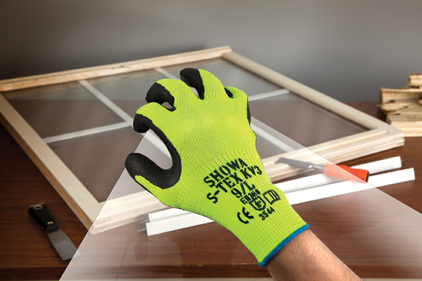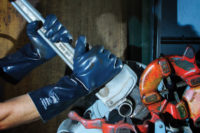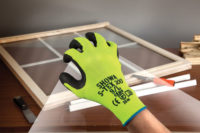White-collar industries are experiencing what we in the industrial market have known for a long time, specialization and expertise outweigh generalization and experience. According to Forbes, people without specialized skills are finding it harder to find work.
In industrial workplaces and hand protection equipment, we’ve long seen this trend to specialization. Who hasn’t heard a phrase along the lines of “a glove for every task and a task for every glove?”
UK case
A recent case in the UK illustrates the importance of wearing the right glove.
A city sanitation worker successfully sued his employer and was awarded more than $150,000 in personal injury damages for an injury he received while at work. The employee cut himself on a sharp object, which was hidden in a pile of trash. The court found that while his employer had provided him with gloves, they were “the wrong type of gloves.”
The court found that the there was a very real possibility that there may be sharp objects hidden in the waste being handled and so the only way of controlling the risk should have been to provide “suitable” and “effective” personal protection equipment, namely cut-resistant gloves.
Most preventable of injuries
According to the National Safety Council, there are 3.4 billion work-related injuries annually with $156.2 billion spent each year on work-related injuries. Slices, cuts and abrasions account for almost 30 percent of the lost time and productivity in the U.S. and almost 80 percent of these incidents involve the hands.
For many years, the glove industry has had a category of gloves called “general purpose.” These gloves were, and are, used by workers in industries as varied as automotive to construction, roofing, mining, fishing, warehousing and roadwork, among others.
With cut injuries to the hand and finger area among the highest incidents for lost work time, it is no wonder there is ongoing and increasing focus being paid to hand protection, the need for specialization and improvements being made in cut-resistant gloves.
Types of cuts
Slicing cuts: These are characterized by the slipping motion of a very sharp edge. The food-handling industry is exposed to this type of hazard on a frequent basis, as well as any industry that uses sharp knives or box cutters in its daily operations.
Abrasive cuts: Common in many industries, a prime example of an abrasive cut is the constant rubbing action of a glove when handling parts with a sharp or jagged edge, i.e. sheet-metal stamping or plastic parts.
Impact cuts: These are not as frequently occurring in the workplace as abrasive and slicing cuts but can happen with a far greater force. An example of this type of cutting accident is being struck by a falling piece of glass or sheet metal. On a smaller scale, impact cuts can happen in the thumb crotch during the normal course of handling sheet-metal or other sharp-edged material.
Glove considerations — general purpose or cut resistant
The consumer in today’s environment is looking for a glove with improved attributes relating to longevity, dexterity, comfort, grip and health. Key trends include a need for less hand fatigue; increased hand coverage protection and no related irritations or allergic reactions associated to polymer choice of latex, nitrile or neoprene.
Protecting hands and finding the right glove doesn’t have to be difficult. A couple key considerations can help determine if a general purpose glove is appropriate or if workers need the extra protection of a cut-resistant glove.
Why is a glove necessary?
To determine the best glove for the application, it is important to determine the hazards involved, the work environment, objects handled and tasks performed.
Where is the location of the risk? Is it just the hand that needs to be protected or do the forearm and arm need protection, too. For instance, a worker operating a saw is placing more than their fingers or hand at risk. A saw blade might cut the wrist; therefore a glove with an extended sleeve may be the right choice.
Do workers need gloves to enhance their grip on objects? Is dexterity important?
Grasping wet or oily objects can be tricky. When workers cannot grasp objects securely, they may slide through their hands, resulting in cut injuries. Employees are working quickly and must have the dexterity and tactile sensitivity to quickly handle small, sharp objects.
One trend in the specialization of glove manufacturing is engineered fibers. Engineered fibers are being combined in new ways to enhance the performance of gloves. Sponge nitrile, PVC, neoprene, natural rubber latex or polyurethane coatings, which add liquid barrier protection to aid in wet, dry, oily grip situations. In addition, some gloves have anti-microbial coatings, hi-vis coloration and other special features.
Is there a risk of abrasion or punctures?
Many gloves are designed to protect from a slash caused by sharp objects, and some provide high levels of puncture resistance from objects such as the ragged edges of a sharp piece of metal. Gloves designed to offer protection against abrasion will have extra padding across the inside of the fingers and palm, but very little across the back of the hand, where it isn’t necessary.
Most gloves for the industrial market carry American National Standards Institute (ANSI) ratings appropriate to their use. Cut-resistant gloves have ANSI ratings from 0 to 5, with five being the highest level of cut resistance. Glove durability, abrasion levels and puncture resistance are also rated.
Sizing and fit
Like Goldilocks, workers need gloves that fit “just right”. Work gloves that are too large will slide around the hands and not provide protection where needed. Gloves that are too small or pinch in certain places may be uncomfortable, and may restrict blood flow and circulation as well as increasing temperature on the hand. Workers who are uncomfortable or hot are at a greater risk of removing their gloves.
Finding the right glove
In addition to improving the performance of their gloves, most manufacturers have programs to help you assess the risk and determine the proper glove usage, as well as online directories that help you navigate the many requirements, such as ANSI levels and other testing standards, material choice, coating and grip textures available.
While any glove is better than no glove, leather, cotton and synthetic gloves offer little to no cut resistance whatsoever. As in the example of our UK worker, the right glove can make all the difference in safety.



